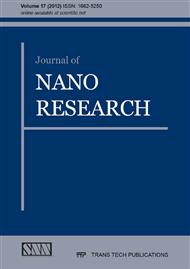[1]
J.P. Chambers, B.P. Arulanandam, L.L. Matta, A. Weis, J.J. Valdes, Biosensor recognition elements. Current Issues of Molecular Biology 10 (2008), 1-12.
Google Scholar
[2]
X. Fan, I M. White, S.I. Shopova, H. Zhu, J. D. Suter and Y. Sun, Sensitive optical biosensors for unlabeled targets: A review, Analytical Chimica Acta 620 (2008) 8-26.
DOI: 10.1016/j.aca.2008.05.022
Google Scholar
[3]
A. Densmore, D. -X. Xu, S. Janz, P. Waldron, J. Lapointe, T. Mischki, G. Lopinski, A. Delâge, J.H. Scmid and P. Cheben, Sensitive Label-Free Biomolecular Detection Using Thin Silicon Waveguides, Advances in Optical Technologies (2008).
DOI: 10.1155/2008/725967
Google Scholar
[4]
R. Horváth , L. R Lindvold and N. B Larsen, Fabrication of all-polymer freestanding waveguides, Journal of Micromechanics and microengineering, 13 (2003) 419–424.
DOI: 10.1088/0960-1317/13/3/310
Google Scholar
[5]
C. A. Mills, E. Martinez, A. Errachid, G. Gomila, A. Samsó, and J. Samitier, Small Scale Structures. The Fabrication of Polymeric Nanostructures for Biomedical Applications using Pattern Replication Techniques, Contributions to science 3(1): 47-56 (2005).
Google Scholar
[6]
C.A. Mills, J. G. Fernandez, A. Errachid, J. Samitier, The use of high glass temperature polymers in the production of transparent, structured surfaces using nanoimprint lithography Microelectronic Engineering. 85 (2008) 1897–(1901).
DOI: 10.1016/j.mee.2008.06.014
Google Scholar
[8]
Ch. Sujatha, G. Mohan Rao, S. Uthanna, Characteristics of indium tin oxide films deposited by bias magnetron sputtering, Materials Science and Engineering, B 94 (2002) 106-110.
DOI: 10.1016/s0921-5107(02)00090-9
Google Scholar
[9]
V. Teixeira, H. N. Cui, L.J. Meng, E. Fortunato, and R. Martins. Amorphous ITO thin films prepared by DC sputtering for electrochromic applications Thin Solid Films , 420–421 (2002) 70–75.
DOI: 10.1016/s0040-6090(02)00656-9
Google Scholar
[10]
J. S. Kim, , M. Granstrom, and R.H. Friend. Journal of Applied Physics, 84 (1998) 6869.
Google Scholar
[11]
E. Shanthi, A. Bannerjee, and V. Dutta. Annealing characteristics of tin oxide films prepared by spray pyrolysis Thin Solid Films, 71 (1980) 237.
DOI: 10.1016/0040-6090(80)90160-1
Google Scholar
[12]
J.C. Jin, and I. Hamberg. Applied Physics Letters , 57 (1987) 149.
Google Scholar
[13]
N. Danson, I. Safi, G.W. Hall, and R.P. Howson. Techniques for the sputtering of optimum indium-tin oxide films on to room-temperature substrates Surface Coating Technology, 99 (1998) 147.
DOI: 10.1016/s0257-8972(97)00436-2
Google Scholar
[14]
M. Alam, and D. Cameron. Optical and electrical properties of transparent conductive ITO thin films deposited by sol–gel process Thin Solid Films, 377 (2000) 455.
DOI: 10.1016/s0040-6090(00)01369-9
Google Scholar
[15]
K. Maki, N. Komiya, and A. Suzuki. Fabrication of thin films of ITO by aerosol CVD Thin Solid Films, 445 (2003) 224.
DOI: 10.1016/j.tsf.2003.08.021
Google Scholar
[16]
Cui, H-N., V. Teixeira, and A. Monteiro. Microstructure study of indium tin oxide thin films by optical methods Vacuum, 67 (2002) 589–594.
DOI: 10.1016/s0042-207x(02)00236-1
Google Scholar
[17]
Lee, J., H. Junga, D. Limb, and K. Yangb. Effects of bias voltage on the properties of ITO films prepared on polymer substrates Thin Solid Films, 480–481 (2005) 157– 161.
DOI: 10.1016/j.tsf.2004.11.144
Google Scholar
[18]
J. O. Carneiro, V. Teixeira, A. João, A. Magalhães, C. Tavares Study of Nd-doping effect and mechanical cracking on photoreactivity of TiO2 thin films Vacuum. 82 (2008) 1475–1481.
DOI: 10.1016/j.vacuum.2008.03.013
Google Scholar
[19]
S.H. Mohamed, F.M. El-Hossary, G.A. Gamal, and M.M. Kahlid. Acta Physica Polonia A, 115 (2009) 704-708.
DOI: 10.12693/aphyspola.115.704
Google Scholar
[20]
Monteiro, A. Revestimentos multicamada PVD com comportamento electrocrómico, Tese de Mestrado. Braga: Universidade do Minho, (2004).
Google Scholar


